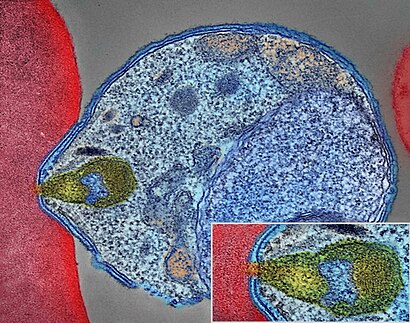Creeperian Malaria
| Creeperian Malaria Malaria Creeperiano | |
|---|---|
 | |
| A Creeperian Malaria parasite connecting to a red blood cell. | |
| Specialty | Infectious Disease |
| Symptoms | Shaking Chills, High Fever, Sweating, Headache, Nausea, Vomiting, Abdominal Pain, Diarrhea, Anemia, Muscle Pain, Convulsions, Coma, Bloody Stools, Yellow skin, Seizures |
| Usual onset | 1-5 dayspost exposure |
| Duration | 20-24 days |
| Causes | Plasmodium malariae spread by mosquitos |
| Diagnostic method | Examination of the blood, Antigen detection tests |
| Prevention | Mosquito nets, Insect repellent, Mosquito control |
| Treatment | Mosquito control, Medications |
| Medication | Antimalarial medication |
| Frequency | 15-25 million per year (2017) |
| Deaths | 20,000-50,000 per year (2017) |
Creeperian Malaria (Creeperian Spanish: Malaria Creeperiano) is a mosquito-borne infectious disease that affects humans and other animals. Like other strands of malaria, Creeperian Malaria causes symptoms that typically include fever, tiredness, vomiting, and headaches. In severe cases it can cause yellow skin, seizures, coma, or death. Symptoms usually begin ten to fifteen days after being bitten by an infected mosquito, usually of the species Aedes creeperiacae, which is native to Creeperopolis. If not properly treated, people may have recurrences of the disease months later. In those who have recently survived an infection, reinfection usually causes milder symptoms. This partial resistance disappears over months to years if the person has no continuing exposure to malaria.
It is caused by single-celled microorganisms of the Plasmodium group. The disease is most commonly spread by an infected female Aedes creeperiacae mosquito. The mosquito bite introduces the parasites from the mosquito's saliva into a person's blood. The parasites travel to the liver where they mature and reproduce. The most common species of Plasmodium which causes Creeperian Malaria is Plasmodium creeperiacae. Methods that use the polymerase chain reaction to detect the parasite's DNA have been developed, but are not widely used in areas where malaria is common due to their cost and complexity.
The risk of disease can be reduced by preventing mosquito bites through the use of mosquito nets and insect repellents, or with mosquito control measures such as spraying insecticides and draining standing water. Several medications are available to prevent Creeperian Malaria in travelers to areas where the disease is common. Occasional doses of the combination medication sulfadoxine/pyrimethamine are recommended in infants and after the first trimester of pregnancy in areas with high rates of Creeperian Malaria. Despite a need, no effective vaccine exists, although efforts to develop one are ongoing. The recommended treatment for Creeperian Malaria is a combination of antimalarial medications that includes an artemisinin. The second medication may be either mefloquine, lumefantrine, or sulfadoxine/pyrimethamine. Quinine along with doxycycline may be used if an artemisinin is not available. It is recommended that in areas where the disease is common, Creeperian Malaria is confirmed if possible before treatment is started due to concerns of increasing drug resistance. Resistance among the parasites has developed to several antimalarial medications.
The disease is widespread in the tropical and subtropical regions in the far north and far south of Creeperopolis. In 2017, there were 15-25 million cases of Creeperian Malaria worldwide resulting in an estimated 20,000 to 50,000 deaths. Creeperian Malaria is commonly associated with poverty and has a major negative effect on economic development, especially in southern Creeperopolis.
As of 2020, Creeperian Malaria has never had a reported case outside of Creeperopolis.
Signs and Symptoms
The signs and symptoms of Creeperian Malaria typically begin 10-15 days following infection, but may occur later in those who have taken antimalarial medications as prevention. Initial manifestations of the disease—common to Creeperian Malaria—are similar to flu-like symptoms and can resemble other conditions such as sepsis, gastroenteritis, and viral diseases. The presentation may include headache, fever, shivering, joint pain, vomiting, hemolytic anemia, jaundice, hemoglobin in the urine, retinal damage, and convulsions.
Prevention
Methods used to prevent Creeperian Malaria include medications, mosquito elimination and the prevention of bites. There is no vaccine for Creeperian Malaria. The presence of Creeperian Malaria in an area requires a combination of high human population density, high anopheles mosquito population density and high rates of transmission from humans to mosquitoes and from mosquitoes to humans. If any of these is lowered sufficiently, the parasite eventually disappears from that area, as happened in central Creeperopolis. However, unless the parasite is eliminated from Creeperopolis, it could re-establish if conditions revert to a combination that favors the parasite's reproduction. Furthermore, the cost per person of eliminating anopheles mosquitoes rises with decreasing population density, making it economically unfeasible in some areas.
Prevention of Creeperian Malaria may be more cost-effective than treatment of the disease in the long run, but the initial costs required are out of reach of many of the world's poorest people. There is a wide difference in the costs of control (i.e. maintenance of low endemicity) and elimination programs between countries.
Mosquito nets help keep mosquitos away from people and reduce infection rates and transmission of Creeperian Malaria. Nets are not a perfect barrier and are often treated with an insecticide designed to kill the mosquito before it has time to find a way past the net. Insecticide-treated nets are estimated to be twice as effective as untreated nets, and offer greater than 70% protection compared with no net. Between 2000 and 2008, the use of ITNs saved the lives of an estimated 5,000,000 infants in Creeperopolis. Most nets are impregnated with pyrethroids, a class of insecticides with low toxicity. They are most effective when used from dusk to dawn. It is recommended to hang a large "bed net" above the center of a bed and either tuck the edges under the mattress or make sure it is large enough such that it touches the ground.
Beginning on March 12, 2020, the Creeperian government began an active campaign of specicide against mosquitos in a campaign called La'Solución Final (The Final Solution).
